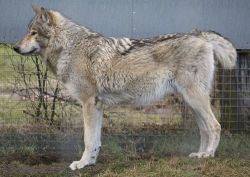Toronto Media Co-op
Local Independent News
Wolves in your Backyard
Living down here in South-Western Ontario, we’re told here are no wolves around. But how do we know there’s no wolves? Most of us only know about wolves by reading books and articles written by someone who claims to know better. However, there are no reliable studies of wolf population and distribution – most numbers and ranges quoted today can be traced back to an ‘estimate’ made by the Ministry of Natural Resources (MNR) over forty years ago! Where does that leave us if we want to know about wolves today? Well, one thing it means is that so-called ‘authorities’ aren’t much more reliable on this subject than anyone else.
There’s plenty of stories about people seeing wolves in this area, mostly along the corridor created by the Niagara Escarpment and the Bruce Trail. But some sightings have occurred in Rockwood along the Eramosa River, just outside of Guelph.
By official reckoning, the southern-most wolf in Ontario is the Eastern Wolf, which is badly endangered and lives mostly in Algonquin Park. Typically, it was dangerous for the wolves to leave the park, because until 2005, it was legal to kill any wolf at any time if they weren’t in a protected area. Wolves can travel 70km a day for many days, and their social structure produces a steady stream of lone wolves who go out looking to form a pack and carve out a territory. Algonquin Park has the highest concentration of wolves in Ontario, so it’s likely that wolves would seek to leave the park if they could. In fact, people have seen them leaving the park to the South in the wintertime, following browsing deer, and they have been reported to have made it as far South-East as Kingston. This phenomenon is common enough that wolves have been given further special legal protection to the South of Algonquin and protected corridors are slowly been established.
Now, probably most of the reported sightings in the South-West are just folks seeing a Coyote, especially because, in this area, many Coyotes have some Eastern Wolf blood in them. However, the MNR states that the main requirements for wolf habitat are a strong population of prey animals and freedom from human interference. The population of White-Tailed Deer, the primary prey of the Eastern Wolf, has been exploding in recent years throughout Southern Ontario, especially in the South-West. And it is possible that changes in laws and in land-use by humans has made this area suitable enough for the Eastern Wolves that the odd group or individual may find a niche in which to survive.
So! How do you know there are no wolves around here? The only way to really answer that question is to go looking for them. The best way to find any creature is to be active when they’re active, and to go where they might want to go. Head out in the early morning before the sun is up and follow a forested corridor out of the city. Look for deer trails and follow them, upwind if possible. Keep low, be silent. Settle into your senses and pay attention to everything you can see, hear, and smell as the sun rises. If you find a spot you feel good about, sit there and wait and watch until the sun is fully risen. Then come back to the same area again the next day or the next week and do the same thing until you know that area well enough to know for sure if wolves are there.
So much of what we know about the land and other creatures is defined by experts who act as intermediaries between us and our own homes and neighbours. But we don’t need to accept the narrative that we’re offered by books, television, and class rooms. By working to build our own relationships with these places and animals, we can gain an understanding that is far truer, and that gives us the strength to act in their defense.
[This article was initially published in The Peak, a magazine out of Guelph. But we've heard tell of interesting wolf sightings happening as far South along the escarpment corridor as St Catherine's, so get looking!]
About the poster
The site for the Toronto local of The Media Co-op has been archived and will no longer be updated. Please visit the main Media Co-op website to learn more about the organization.
